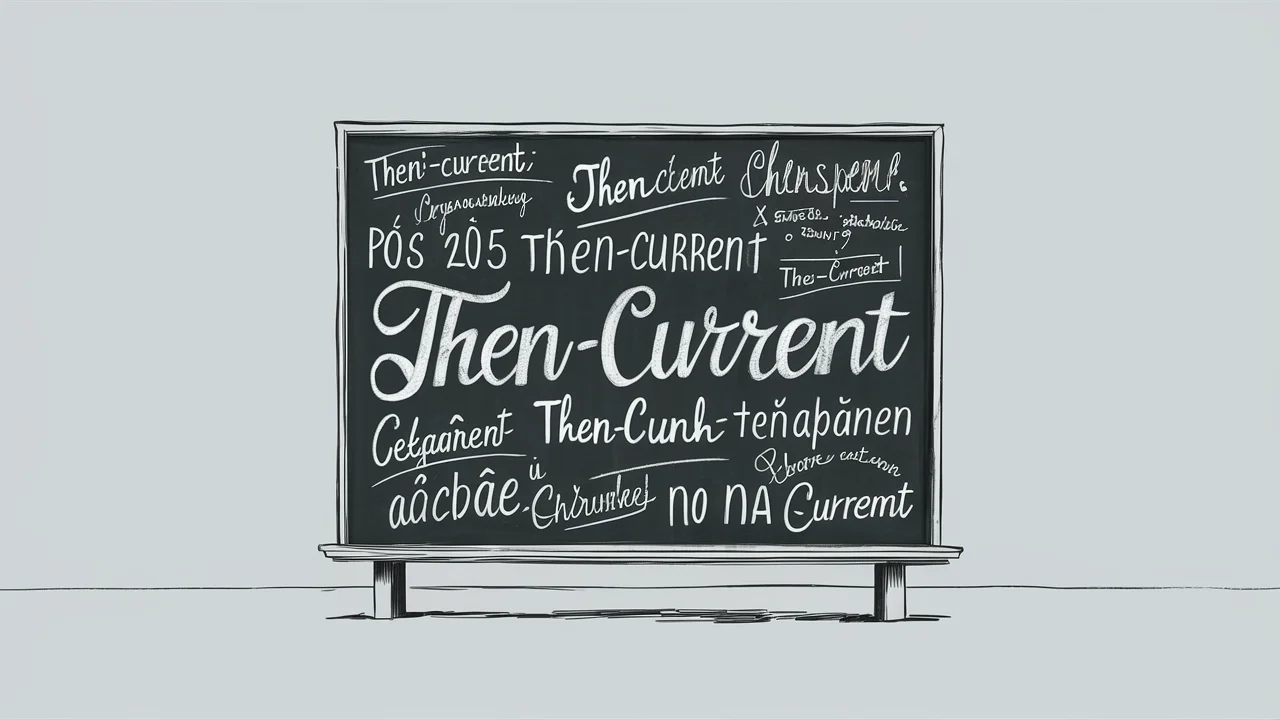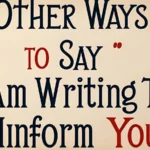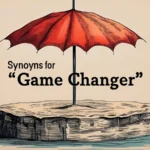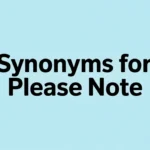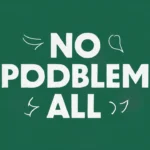Picture this: You’re reading a contract, and suddenly, you see the phrase then-current interest rate. What does that even mean?
Well, it’s just a fancy way of saying the rate at that specific time. It’s used in legal documents, policies, and agreements to refer to something that was in effect at a particular moment. But let’s be real—“then-current” sounds kind of stiff, right?
Luckily, there are plenty of other ways to say it! Whether you’re writing an email, explaining something to a friend, or just trying to avoid sounding like a robot, you’ve got options. In this article, we’ll explore different ways to replace “then-current” with something more natural. And don’t worry—we’ll keep it fun, relatable, and easy to understand. So, let’s dive in!
At That Time
This is probably the easiest and most natural swap for “then-current.” It tells you exactly when something happened—without any unnecessary fluff.
Let’s say you’re talking about a store’s return policy from last year. Instead of saying, The then-current policy required receipts, you can simply say, The policy at that time required receipts. See? Easy!
It also works in casual conversations. Imagine your friend asks, “What was gas like in 2010?” Instead of sounding like a legal document, you can say, At that time, gas was way cheaper than today! It’s simple, clear, and sounds like something you’d actually say in real life.
Read more: Other Ways to Say “As Per Your Request”
At That Moment

This phrase works best when talking about something more immediate. It’s great for storytelling, especially when describing quick changes.
For example, let’s say you’re telling a dramatic story about losing your Wi-Fi right before submitting an assignment. Instead of saying, My then-current internet connection failed, you can say, At that moment, my Wi-Fi decided to betray me!
See how much more fun that sounds? “At that moment” makes things feel more vivid—like you’re reliving the experience. It’s a great option when you want to add a little drama or excitement to your words.
At That Point

Want to sound a little more polished while still keeping it simple? “At that point” is your go-to phrase.
It works really well when describing a progression of events. Imagine you’re telling a story about switching jobs. Instead of saying, My then-current job was boring, you can say, At that point, my job wasn’t exciting anymore, so I started looking for something new.
It feels natural and flows smoothly in both casual and professional settings. Whether you’re chatting with a friend or writing an email, this phrase keeps things clear without making you sound like a lawyer.
The Existing
This one works best in professional or business settings. It’s a bit more polished than casual speech but still way better than “then-current.”
For example, let’s say a company is updating its policies. Instead of saying, The then-current guidelines were updated, they could say, The existing guidelines were updated to reflect new changes. It gets the point across without sounding too formal.
It’s also great for technology-related discussions. If someone asks about software features, you can say, The existing version of the app supports these functions. It’s clean, professional, and straight to the point.
The Present

This phrase is another solid alternative, especially when referring to something that’s happening right now.
Let’s say you’re discussing rental prices in your city. Instead of saying, The then-current rates were high, you can say, The present rates are still rising! It makes your statement feel more immediate and relevant.
It’s also helpful when comparing past and present situations. For example, Back then, we had dial-up internet, but the present technology is much faster. It’s a smooth way to transition between timeframes while keeping things natural.
The Active
“The active” works best when talking about rules, policies, or systems currently in place.
For example, if a school updates its dress code, instead of saying, The then-current dress code allowed hats, you can say, The active dress code now bans hats.
This phrase is great when discussing ongoing changes. It helps clarify what’s still in effect while keeping things simple. It’s especially useful in workplaces, policies, or anything that changes over time.
The Ongoing
This one has a slightly different tone—it emphasizes something that’s still happening or evolving.
Imagine you’re talking about a major road construction project. Instead of saying, The then-current construction plan included new bike lanes, you can say, The ongoing construction project includes new bike lanes.
It gives a sense of movement, making your sentence feel more dynamic. Perfect for discussions about projects, policies, or even personal goals that are still in progress!
The Current at That Time
Sometimes, you want to be super clear. “The current at that time” is a direct and simple way to replace “then-current” without losing any meaning.
For example, if you’re talking about interest rates from two years ago, you could say, The current rates at that time were much lower than today. It’s a bit longer than other options, but it keeps things crystal clear.
The Version in Effect
This phrase works best for policies, rules, and guidelines. It emphasizes that something was officially in place during a specific time.
For example, instead of saying, The then-current policy required two forms of ID, you can say, The version in effect required two forms of ID.
This wording is often used in legal or corporate settings, but it still feels natural enough to use in everyday speech when needed.
The Standing
This one has a slightly formal feel but still works well in professional conversations.
For example, The standing rule was that all employees had to clock in by 9 AM. It sounds clean and clear without being overly complicated.
It’s a great way to refer to long-standing policies, rules, or traditions that were in place during a particular time.
The Applicable
This phrase is another great choice for legal or policy discussions.
Instead of saying, Under the then-current guidelines, refunds were not allowed, you can say, Under the applicable guidelines, refunds were not allowed.
It’s simple, professional, and straight to the point. Perfect for any formal document or discussion!
The Running
“The running” works well when talking about things like trends, programs, or operations.
For example, The running promotion at the time offered discounts on all items. It’s a natural way to highlight something that was active during a particular period.
The Relevant
When discussing information that mattered at a specific time, “the relevant” is a great option.
For example, The relevant rules at the time required safety gear. It’s direct, professional, and keeps things clear.
The Valid at That Time
If you’re talking about something official—like a law, policy, or contract—this phrase is perfect.
For example, instead of saying, The then-current warranty covered accidental damage, you could say, The warranty valid at that time covered accidental damage. It makes things clear while keeping the sentence smooth and easy to read.
This phrase works well in business or legal settings where accuracy matters. It emphasizes that something applied only during a specific period without making things sound overly complicated.
The Effective
“The effective” is a simple yet professional way to say “then-current.”
For example, The effective interest rate at the time was 5%. It’s often used in legal, financial, and business documents, but it’s easy to understand in everyday speech too.
This phrase is great when talking about laws, regulations, and policies because it focuses on what was officially in place at a certain moment.
The In Force
This phrase is another strong choice for official rules or policies.
For example, The rules in force at the time required all employees to sign in daily. It’s clear, direct, and keeps things sounding professional without being too formal.
It works well when talking about regulations, contracts, or even general guidelines that were active during a specific period.
The Governing
“The governing” is useful when referring to laws, policies, or regulations that applied at a given time.
For example, instead of saying, Under the then-current tax code, deductions were limited, you could say, Under the governing tax code at the time, deductions were limited.
It’s a strong, authoritative way to phrase things, making it a great option for legal or professional discussions.
The Existing at That Time
If you need a phrase that’s both clear and conversational, this one works well.
For example, The existing rules at that time required helmets for all riders. It’s straightforward and keeps the focus on what was in place during a specific moment.
This phrase works well in both casual and professional settings, making it a versatile choice.
The Active at That Moment
When discussing something that was happening right then, “the active at that moment” is a great option.
For example, The active policy at that moment allowed employees to work from home. It highlights the temporary nature of the rule while keeping the sentence easy to follow.
This phrase is especially useful when discussing changing policies, rules, or systems that were in place for a short time.
The Operational
If something was running or functioning at a certain time, “the operational” is a perfect fit.
For example, The operational system at the time required manual approvals. It sounds professional but still easy to understand.
This phrase is particularly useful for technology, business, and logistical discussions where you’re talking about something that was in use during a specific moment.
Now, with all these alternatives, you’ll never have to use “then-current” again! Whether you’re writing an email, drafting a report, or just explaining something in conversation, these phrases will help you sound clear, natural, and confident. So go ahead—ditch the stiff language and use words that actually make sense!
Final Thought
So, there you have it! “Then-current” might sound stiff and outdated, but there are plenty of natural, engaging ways to replace it. Whether you’re chatting with friends, writing an email, or explaining something important, you now have a variety of options that sound clear and natural.
Next time you’re tempted to say “then-current,” try swapping it out with one of these alternatives. You’ll sound more relatable, more natural, and—let’s be honest—way less like a legal textbook. Now go forth and simplify your speech like a pro!

James Carter is a language expert at WordSeekerz.com, dedicated to making English grammar and vocabulary simple and engaging. Explore more at WordSeekerz.com and enhance your language journey today!
